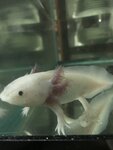Keep both axolotls tubbed until your tank is cycled.
Your white axie does seem to be suffering from poor water quality; that's the cause of both the spots on the tail and the shortened gills (bad water quality is often the reason for gill shrinkage).
For more info on cycling (long post ahead, be warned):
What you want to be doing with your tank is building up the nitrogen cycle between the filter, the substrate, and your eventual axolotl inhabitants. The way the nitrogen cycle works is:
1. Detritus from the inhabitants decomposes into the water, releasing
ammonia, which is extremely toxic to fish/aquatic animals.
2. Bacteria called
Nitrosomonas (they will live in your filter, substrate, and other spaces with large surface area) break the ammonia down into
nitrite, which is less harmful for the tank's inhabitants, but still isn't healthy.
3. Another species of bacteria,
Nitrobacter, breaks the nitrite down into
nitrate. This is the final step of the cycle; nitrate is the least harmful to aquarium inhabitants, and you can keep it at manageable levels with regular water changes.
So how do you start this cycle in your aquarium, and maintain it?
The first step is providing some ammonia, so
Nitrosomonas can feed on it. You can get ammonia from many sources, but the easiest way I've found is to either buy pure liquid ammonia and put in a very small amount, or drop in some fish food so it can decompose and release ammonia.
Once you have an ammonia source, start to test the water every day for ammonia, nitrite, nitrate, and pH. Your ideal parameters should be Ammonia <0.06, Nitrite 0, Nitrate 0. You will start with an ammonia spike, as the
Nitrosomonas start feeding on the ammonia, and then your ammonia should gradually taper down over the next two weeks as the
Nitrosomonas becomes established.
Next is your nitrite spike. This occurs when the
Nitrosomonas is breaking down the ammonia, but the
Nitrobacter has not started to colonize and feed on the nitrite yet. This will last around another 2 weeks, during which your parameters should be Ammonia 0, Nitrite <0.75, Nitrate 25.0.
Lastly you'll have nitrate buildup, which happens when both your bacterial colonies are well established. This usually comes 6 to 7 weeks after beginning to cycle the tank; a good marker for when your tank has fully cycled is when your nitrite and ammonia levels are both very low or zero, and your nitrate levels are over 25. Once you get to this point, you can reintroduce your axolotls to your tank, and do weekly water changes from there.
So, that's how tanks cycle. But seven weeks is a long time to keep two separate axolotls in tubs, doing 100% water changes daily! So are there any steps you can take to speed up the cycle? Short answer: maybe, long answer: it's complicated.
While some aquarists do fish-in cycling (keeping the fish in the tank as it cycles), this is largely considered to be inhumane and dangerous to axolotls, as the ammonia and nitrite buildups can give your animal serious ammonia burns or even kill it. I ran my axolotl through his cycle fish-in, because I didn't have any other options at the time; the only reason I felt comfortable doing so was because I did massive daily water changes and was keeping him in a large tank for his size. Doing that much water changing also slows the cycle way down, so expect it to take closer to six months to finish the nitrogen cycle.
The best option to help speed up your cycle (although you can't avoid it entirely) is to find a local fish-keeper who has a dirty filter they'll let you take. Filters are often where bacterial colonies like to live most, so grabbing an old filter or filter piece from someone whose tank has already cycled and had bacteria established can give you a head start on the bacteria you need. If you do this, keep the filter wet, because the bacteria will die if the filter dries up, and continue to monitor water parameters until your nitrate levels are 25+ and everything else is 0 or close to 0.
Last, a little side note: There are many branded "head start" options that claim to help cycle your aquarium. I've tried one, and I have no idea if it made a difference or not; my tank cycled in around two months, but I don't have a "control tank" to see how long it would have taken otherwise. Largely, I'd be distrustful of bacteria-in-a-bottle, because they're living creatures that don't do well just sitting around. The ideal solution is to get an old filter from a pet shop (if they let you) or a friend; it's free, and it'll probably work just as well.
Sorry for the insanely long post and explanation; I hope this helps you with your nitrogen cycling adventures, though! Good luck and happy axie-keeping


